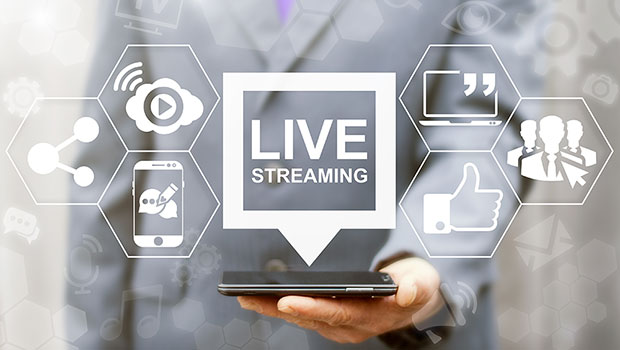When live streaming first started to roll out across multiple social media platforms, it remained pretty unclear how this new technology would interface with Internet users. More often a source for friends to include one another on events they’re missing out on, frequent uses of live video streaming felt experimental in nature.
What was it all about? How could I interface with it? Facebook and Instagram live streams felt like happy accidents, with users hopping on for a few minutes only to jump off again.
Nobody knew quite what to do with it at the beginning, but one thing was for certain: The ability to instantly start up a video stream and broadcast to users seemed like a Great Democratizer in the world of media.
For decades, live video was associated with the riches of major television networks. The infrastructure necessary to go live was so far removed from the public consciousness that it wasn’t even a thought for the Average Joe to explore. Being able to sit on your couch, grab a device out of your pocket and sing a song to the world in a matter of moments was unthinkable for quite some time.
Now, with the advent of live streaming through social media platforms, the playing field feels leveled. No longer are satellites and television studios with millions of dollars in equipment necessary. Suddenly your cellphone had the potential to broadcast to an unlimited audience at a moment’s notice, anywhere and at any time.
Fast-forward a few years and live streaming still feels in its infancy when it comes to maximizing its capability. However, it undoubtedly has soared in this time through adaptations and social media resources, and particular communities are thriving exponentially from its use.
However, we still haven’t quite figured out what live streaming can mean for business and marketing. It’s undoubtedly an alluring, dynamic platform. Any time video is introduced into the fray, you’re sure to garner much more attention than you would with written content. Still, in order to master live video — make it a worthwhile use of time that your audience will enjoy, learn from and look forward to — direction seems to be needed.
Whether you’re new to the game of video marketing implementation or a seasoned video vet, it’s almost certain that some new ideas about live streaming could make a world of difference in your approach. Maybe you don’t know where to get started, you’re in search for new ideas, or you just want an alternate take on the medium. Regardless, following are some pointers on getting your live streaming marketing campaign off the ground.
Creativity Is the Name of the Beginner’s Game
The number of people who can start a live stream with a phone camera fixed on their face as they tell their audience how their day is going is fairly limited. It’s typically reserved for mega celebrities and social media dynamos. It can be a true challenge to stay compelling as a talking head. We need live streaming solutions that work for all parties, regardless of video prowess.
When you’re just getting started with live video streaming, please do not resort to the tactic of pressing record and giving it a go from your office. As with live television, you have a limited opportunity to capture an audience, keep them entertained, and keep them coming back for more.
Your audience will tune in once for 15 seconds and be very hard-pressed to come back if you start off without a plan and it turns out to be a flub.
Instead, mix up your content stream a few ways. It’s OK to schedule live feeds on certain dates; you can figure out what’s really working for you when your viewers return next week. However, don’t do the same thing every time.
Live stream a tour of your facilities during a company event. If you’re heading to the production side, grab your camera and give a little insight on the ins and outs of making your product. Schedule tech appointments to demonstrate common software fixes. Host a random sit-down interview with a company VIP. There are endless options, and it’s your job to switch things up until those options seem completely exhausted.
Live Streaming: Proven Methods for Success
Want to know the truly exciting thing about getting started in live streaming? You don’t have to set out and reinvent the wheel. Being creative doesn’t mean starting from scratch with every single stream; in fact, if you’re doing so you’re likely missing out on the point of efficiency that live streaming delivers to businesses and marketing teams.
Instead, identify a handful of methods that will work well with your live stream design. Structure around bullet point initiatives — things that will get you going — and just roll with it. You don’t want it to have zero direction, but you also do not want your video to feel overproduced. Be authentic and organic, with a guiding motif, and take off.
OK, so what are some ways you can get started? There are a few techniques you might find worthwhile as starting places — launchpads to the world of live streaming. A fantastic idea to lead off with is a simple Q&A session with your customers. You can organize this in a variety of ways. One simple and successful way would be to set up a whiteboard and ask followers to throw out questions on the live stream. You can answer them on the fly, and have a teammate collect a list of ongoing questions should you receive numerous responses.
Come prepared! Viewership might be low in the beginning, and you have to be ready for little — or no — engagement early on. Have a few questions ready to roll beforehand in case that happens. Keep it short, and leave it hanging for the next time; you don’t have to exhaust the entire method in one go.
Another classic concept from the same tree of ideas is to invite a tech support member and host a customer support Q&A. This can serve as a knowledgeable inquiry for existing customers, as well as offer necessary background for curious would-be customers on the inner workings of your products on a low-stakes friendly and outgoing platform.
The beauty of live streaming is that it lends itself very well to surprises. One method to boost followers and generate some intrigue is by making a special announcement on your live stream. It could be the introduction of a new product line, a new promotion for customers — literally anything you want it to be. It doesn’t have to be grand and spectacular. You can wow your viewers simply by giving them exclusive access to something that feels important or valuable to them.
The reality of live streaming is that much like video content itself, the scope of what you do as a business is really remarkable and dynamic. These are a few ideas to get you started with an outline, but feel free to experiment. Embrace your own creativity through the process and you’ll find a treasure chest of options awaiting.
Don’t Doubt the Data
One great thing that most streams will provide are analytic tools that can measure your productivity on your stream. These might not be the most advanced metrics in the world, and for analytic geeks out there like myself they might seem rather bare bones. However, as any devoted data cruncher can tell you, it only takes a few basic numbers to produce an array of marvelous insights.
Let’s use Facebook Live as our playground for this thought experiment. There are a half dozen built-in analytic tools that Facebook places at your disposal to measure live stream performance. The first we’ll look at is Post Performance, which can be found under the ‘Posts’ tab in the Page Insights.
Live stream posts will have a video camera icon by them. The Post Performance will give you a holistic view to compare and contrast how video and live stream posts are performing in comparison to other formats, like shared videos, text posts or links. You can see audience reach and engagement with slick bar sliders that visually represent your data.
The next stat to look at is the Facebook Video engagement tool. This metric will demonstrate the scope of your viewership, represented by percentage of viewers that resorted to some form of action based on your video.
You can see that your page has 10,000 followers, your video reached 1,500 followers, and that 2 percent of that 1,500 engaged in some form with your video, for example. The metrics allow you to dive further, seeing specifically what types of engagement took place. You can get a charted breakdown showing how your live stream performed — whether followers reacted to the live stream with an emoji, sent a comment your way, or shared the video link on their own stream.
The Viewer Retention metric is another data point that is critical when assessing what types of videos are and are not working for your organization. Go to the ‘Post Details’ tab and select Video. This tab will give you a breakdown of number of viewers and what your peak performance was in terms of number of viewers. (A view, in Facebook’s terms, is constituted by a three second or longer stay on a video stream.)
You also can find average length of viewership and number of 10-second views to discover whether your whole video was viewed. You’ll get further overall information, like total minutes of content viewed on your stream, as well.
An overlooked metric on Facebook Live is the “clicks” data point, which shows how many times viewers chose to start a video themselves, rather than scrolling through their newsfeeds. You also can measure how viewers respond to calls to action post-viewing, specific to ad campaigns that seek further action like a sale component.
Other points to look at are organic versus paid reach, which shows you the where of your video traffic and gives you more insights into your brand’s performance in retention actions. Organic reach will vary by industry, of course, but a strong average retail is around 7 percent, while travel- and leisure-designated pages hit closer to a one-third mark.
The sheer amount of content produced and distributed on social media means that a lot of avenues are taking a cut in these margins. Facebook has recommended that users make use of boosted posts and standalone ads to offset the flow of content and let their work rise to the top.
Facebook’s algorithm is heavily dependent on targeted viewership; it wants Facebook users to be matched with content as well as possible. This means boosting live streams in a way that targets specific, like-minded individuals within the demographics that your typical clientele represent.
A final point from Facebook is the “Negative Feedback” measure, which shows how many users chose to hide your post, the number of spam reports, and number of unlikes that followed the viewing of a video. This is an excellent stop-gap tool for preventative follower maintenance, and it provides invaluable insights into how your live streams affect your clientele.
These types of data points will look different for other social media streams, but play around with the settings and you’ll find that they’re widely available across platforms in one way or another. Track, monitor and use data to enhance your live streams through the unbiased voice and guidance that numbers provide.
Spontaneous Does Not Mean Unplanned
This is one of the biggest mistakes we see with live streaming. There’s this sense that because it’s live, video content can be random and unplanned. Just pick up your phone and go! Sure, there are times when that’s not the worst thing in the world. Maybe something really special is happening at your office and you want your audience to catch a glimpse. For the other 99 percent of the time, you need to plan your live streaming event.
Test your WiFi above everything else. Having a poor feed is going to guarantee that viewers drop immediately, no matter how great the content is. At least a 2-MB upload speed is recommended to get you going. You’ll find a number of test sites online that will give you an idea of where your connection is on that spectrum in a matter of seconds.
Think about the location, the lighting, what you want to capture. The logistics are much more important than “grab and go.” Taking it outside? Think about the weather. Always run tests before going live. You really should consider the idea that viewers know when content isn’t going to be good, and the likelihood of them returning drops with bad feeds and setup.
Let Your Goal Inform Your Platform
You don’t have to be terribly rigid with how you go about developing the actual content. The worst thing in the world is bad acting (unless you’re trying to be so bad that it’s actually good). Be loose, focus on your featured guests, but plan the logistics and think about your goal.
Do you want to direct viewers toward a new product link? Maybe have them sign up for an email list? That’s totally fine, but ensure that you’re giving them every opportunity to do so throughout the stream.
Be creative with your directing; put a physical example of the call to action in your video. Have it written on a whiteboard in the background that makes it look like a thought bubble coming from your head — whatever it takes to show effort and entertain.
Also, think about where you want the live stream to feed. Facebook, YouTube, Instagram, Livestream, Periscope and Vimeo Live are the big players in the field. Consider where your primary audience is and focus your efforts, or if you’re intending on growing a particular audience, direct traffic there.
At the same time, you want all eyes on you; if you have a small audience on one platform compared to another, it would be recommended to go with the larger audience and keep that momentum going.
Leveraging Beyond the Live Stream
The central attraction to a live stream is right there in the name: live. Hopping into an online community that’s live feels much more inclusive and exhilarating than watching a recorded and shared video. You can learn something new collectively, or serve as witness to an awesome surprise announcement for a company you and other viewers adore.
As a viewer, you can watch with fellow product patrons from around the world and participate live in discussions, be heard by representatives from the company, and interact in a tremendous social media experience.
So it might seem shocking when we follow that up with this statement: Your live stream is valuable, even when it’s no longer live. How can this be? It’s all about content maximization — getting the most bang for your buck by absorbing the mottoes of an efficient marketing stream and stretching every second of video into something worthwhile for your funnel.
Imagine the effort spent constructing outlines for a live feed, creating interview questions for personnel for a Q&A, or developing an idea for your staff speaker series after deciding the best route to go would be live streaming the event. They’re all fantastic ideas, but what becomes of that rich content once the stream goes offline?
Many social media outlets have been transitioning toward caching your live streams, but there’s no reason you can’t repackage the video and publish it later for viewers who simply couldn’t make it to the show on time.
Consider your social media stream as your DVR. Reuse video content material and repurpose it for future videos. If there was a 15-second clip that summarizes your company in a nutshell, or a tech inquiry in a customer support live stream that gets asked all-too often, grab it, store it and run with it.
Make the most of your live stream by extending your actions beyond the live and into the shared video and knowledge database realm.
The Why of Live Streaming: Final Thoughts
Video is the platform for now. It would be unthinkable in 2019 for a marketing team not to incorporate video into some mechanics of their campaign and philosophy. Live streaming is just one avenue — a surprisingly complicated one, but increasingly vital — for brands around the globe.
People enjoy watching video content, and live video augments the experience tenfold by creating content based on shared experiences.
Four out of five viewers in one study, a survey conducted by Livestream and New York magazine, indicated they would prefer to view live content and video from a brand over reading a blog post. Surprisingly, that number held when live video was compared to social media posts, with 82 percent of those surveyed saying that they would prefer live video from a brand.
Decades ago, live television transformed advertising and pushed markets to unseen heights. Unfortunately for many, those markets were beyond the reach of 99 percent of businesses. Now the platform has been equalized.
With diverse brands taking full advantage of this platform — ranging from Buzzfeed to Taco Bell, Nissan to Yeti, and so many more — why not take a stab at it? Utilize the aforementioned techniques, have fun with it, and watch your brand recognition prosper!













































